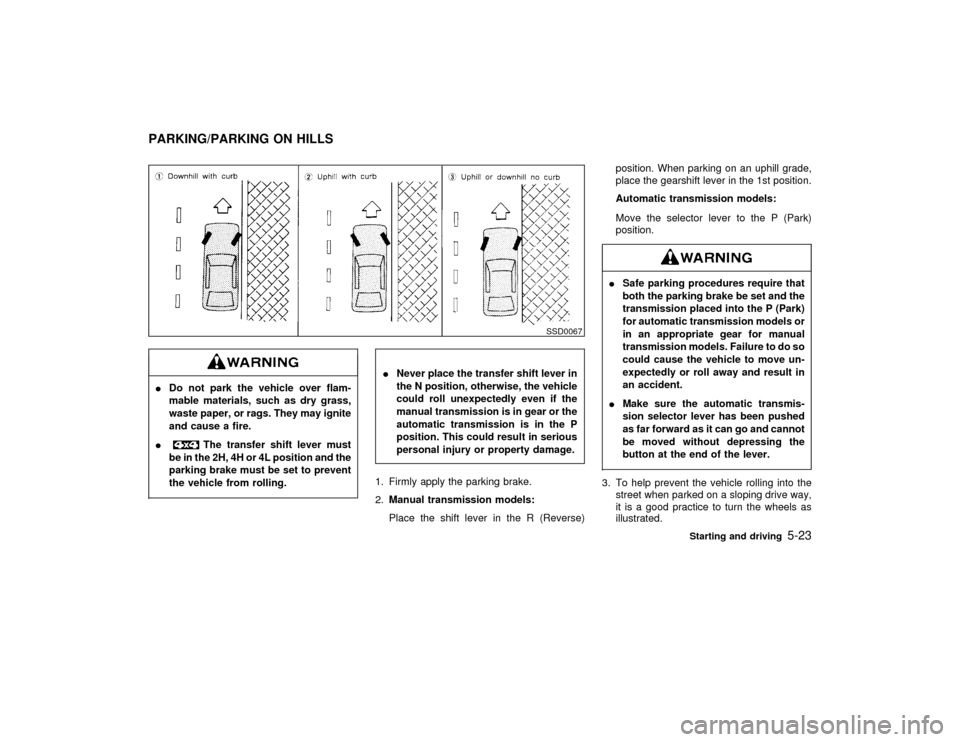1998 NISSAN PATHFINDER manual transmission
[x] Cancel search: manual transmissionPage 150 of 249

IDo not park the vehicle over flam-
mable materials, such as dry grass,
waste paper, or rags. They may ignite
and cause a fire.
I
The transfer shift lever must
be in the 2H, 4H or 4L position and the
parking brake must be set to prevent
the vehicle from rolling.
INever place the transfer shift lever in
the N position, otherwise, the vehicle
could roll unexpectedly even if the
manual transmission is in gear or the
automatic transmission is in the P
position. This could result in serious
personal injury or property damage.1. Firmly apply the parking brake.
2.Manual transmission models:
Place the shift lever in the R (Reverse)position. When parking on an uphill grade,
place the gearshift lever in the 1st position.
Automatic transmission models:
Move the selector lever to the P (Park)
position.
ISafe parking procedures require that
both the parking brake be set and the
transmission placed into the P (Park)
for automatic transmission models or
in an appropriate gear for manual
transmission models. Failure to do so
could cause the vehicle to move un-
expectedly or roll away and result in
an accident.
IMake sure the automatic transmis-
sion selector lever has been pushed
as far forward as it can go and cannot
be moved without depressing the
button at the end of the lever.3. To help prevent the vehicle rolling into the
street when parked on a sloping drive way,
it is a good practice to turn the wheels as
illustrated.
SSD0067
PARKING/PARKING ON HILLS
Starting and driving
5-23
Z
01.1.31/R50-D
X
Page 157 of 249

CHANGING A FLAT TIREIf you have a flat tire, follow the instructions
below.Stopping the vehicle1. Safely move the vehicle off the road away
from traffic.
2. Turn on the hazard warning flasher.
3. Park on a level surface and apply the
parking brake. Shift the manual transmis-
sion into reverse (automatic transmission in
P).
The transfer control lever must
be in the 2H, 4H or 4L position.
Never place the transfer control lever in
the N position. Otherwise, the vehicle
could roll unexpectedly even if the
manual transmission is in gear or the
automatic transmission is in the P posi-
tion. This could result in serious per-
sonal injury or property damage.
4. Turn off the engine.5. Raise the hood to warn other traffic and to
signal professional road assistance person-
nel that you require assistance.
6. Have all passengers get out of the vehicle
and stand in a safe place away from traffic
and clear of the vehicle.
IMake sure that the parking brake is
securely applied and the manual
transmission is shifted into R (re-
verse), on the automatic transmis-
sion in P (Park).
INever change tires when the vehicle
is on a slope, ice or a slippery area.
This is hazardous.
INever change tires if oncoming traffic
is close to your vehicle. Wait for pro-
fessional road assistance.
Blocking wheelsPlace suitable blocks at both the front and
back of the wheel diagonally opposite the flat
tire.Be sure to block the wheel as the vehicle
may move and could cause personal
injury.
MCE0001
FLAT TIRE6-2
In case of emergency
Z
01.1.31/R50-D
X
Page 166 of 249

ground as this may cause serious
and expensive damage to the trans-
mission.
TOWING RECOMMENDED BY
NISSANNISSAN recommends that your vehicle be
towed with the driving (rear) wheels off the
ground as illustrated.
IWhen towing with the front wheels on
the ground: Turn the ignition key to
the OFF position and secure the
steering wheel in a straightahead po-
sition with a rope or similar device.
Never place the ignition key in the
LOCK position. This will result in
damage to the steering lock mecha-
nism.
IWhen towing manual transmission
models with the rear wheels on the
ground (if you do not use towing
dollies): Always release the parking
brake and move the transmission
shift lever to the N (neutral) position.Observe the following restricted towing speeds
and distances.
ISpeed: Below 60 MPH (95 km/h)
IDistance: Less than 500 miles (800 km)
If the speed or distance must necessarily be
greater, remove the propeller shaft beforehand
to prevent damage to the transmission.
SCE0197
In case of emergency
6-11
Z
01.1.31/R50-D
X
Page 167 of 249

NISSAN recommends that a dolly be used as
illustrated when towing four wheel drive mod-
els.
When towing with the front wheels on
the ground or with the rear wheels on
the ground (if you do not use towing
dollies): Move the transfer case shift
lever into the 2H position.
IWhen towing with the front wheels on
the ground: Turn the ignition key to
the OFF position and move the trans-
mission shift lever to the N (neutral)
position, on automatic transmission
models to move the selector lever to
N (neutral) position, turn the ignition
key to the ACC position. After moving
the selector lever to the N (neutral)
position. Turn the ignition key to the
OFF position and secure the steering
wheel in a straightahead position
with a rope or similar device. Never
place the ignition key in the LOCK
position. This will result in damage to
the steering lock mechanism.
IWhen towing manual transmission
models with the rear wheels on the
ground:
Always release the parking brake andmove the transmission shift lever to
the N (neutral) position.
Observe the following restricted towing speeds
and distances.
Speed: Below 60 MPH (95 km/h)
Distance: Less than 500 miles (800 km)
If the speed or distance must necessarily be
greater, remove the front and rear propeller
shafts beforehand to prevent damage to the
transmission.
SCE0198
6-12
In case of emergency
Z
01.1.31/R50-D
X
Page 177 of 249

When performing any inspection or mainte-
nance work on your vehicle, always take care
to prevent serious accidental injury to yourself
or damage to the vehicle. The following are
general precautions which should be closely
observed.IPark the vehicle on a level surface,
apply the parking brake securely and
block the wheels to prevent the ve-
hicle from moving. For a manual
transmission, move the shift lever to
Neutral. For an automatic transmis-
sion, move the selector lever to P
(Park).
IBe sure the ignition key is in the OFF
or LOCK position when performing
any replacement or repair.
IIf you must work with the engine
running, keep your hands, clothing,
hair and tools away from moving fans
and fan belts.
IIt is advisable to remove necktie and
any jewelry, such as rings, watches,
etc. before working on your vehicle.IAlways wear eye protection when-
ever you work on your vehicle.
IIf you must run the engine in an
enclosed space such as a garage, be
sure there is proper ventilation for
exhaust gases.
INever get under the vehicle while it is
supported only by a jack. If it is nec-
essary to work under the vehicle,
support it with safety stands.
IKeep smoking materials, flame and
sparks away from fuel and battery.
IThe fuel filter or fuel lines should be
serviced by a NISSAN dealer because
the fuel lines are under high pressure
even when the engine is off.
IDo not work under the engine hood
while it is hot. Always turn off the
engine and wait until it cools down.
INever connect or disconnect either
the battery or any transistorized com-ponent connector while the ignition
key is on.
IAvoid direct contact with used engine
oil. Improperly disposed motor oil and/
or other vehicle fluids can hurt the
environment. Always conform to lo-
cal regulations for disposal of vehicle
fluid.
This ª8. Do-it-yourselfº section gives instruc-
tions regarding only those items which are
relatively easy for an owner to perform.
You should be aware that incomplete or im-
proper servicing may result in operating diffi-
culties or excessive emissions, and could af-
fect your warranty coverage.If in doubt about
any servicing, have it done by your NISSAN
dealer.
MAINTENANCE PRECAUTIONS8-2
Do-it-yourself
Z
01.1.31/R50-D
X
Page 214 of 249
![NISSAN PATHFINDER 1998 R50 / 2.G Owners Manual SCHEDULE 1Abbreviations: R = Replace I = Inspect. Correct or replace if necessary. L = Lubricate [ ]: At the mileage intervals onlyMAINTENANCE OPERATIONMAINTENANCE INTERVAL
Perform at number of miles, NISSAN PATHFINDER 1998 R50 / 2.G Owners Manual SCHEDULE 1Abbreviations: R = Replace I = Inspect. Correct or replace if necessary. L = Lubricate [ ]: At the mileage intervals onlyMAINTENANCE OPERATIONMAINTENANCE INTERVAL
Perform at number of miles,](/manual-img/5/609/w960_609-213.png)
SCHEDULE 1Abbreviations: R = Replace I = Inspect. Correct or replace if necessary. L = Lubricate [ ]: At the mileage intervals onlyMAINTENANCE OPERATIONMAINTENANCE INTERVAL
Perform at number of miles, kilometers
or months, whichever comes first.Miles´1,000 3.75 7.5 11.25 15 18.75 22.5 26.25 30 33.75 37.5 41.25 45 48.75 52.5 56.25 60
(km´1,000) (6) (12) (18) (24) (30) (36) (42) (48) (54) (60) (66) (72) (78) (84) (90) (96)
Months 3 6 9 12 15 18 21 24 27 30 33 36 39 42 45 48
Chassis and body maintenance
Brake lines & cablesIIII
Brake pads, discs, drums & liningsIIIIIIII
Automatic transmission & transfer fluid,
manual transmission & differential gear oil
(exc. LSD)See NOTE (1)IIII
Limited-slip differential (LSD) gear oil See NOTE (1)IRIR
Steering gear & linkage, axle & suspension partsIIIIIIII
Drive shaft boots & propeller shaft (
) IIIIIIII
Propeller shaft grease See NOTE (2)LLLLLLLL
Front wheel bearing grease (4x2)II
Front wheel bearing grease (
) See NOTE (3)IRIR
Exhaust systemIIIIIIII
Supplemental air bag system See NOTE (4)
NOTE: (1) If towing a trailer, using a camper or a car-top carrier, or driving on rough or muddy roads, change (not just inspect) oil at every 30,000 miles(48,000 km)
or 24 months except for LSD. Change LSD gear oil every 15,000 miles (24,000 km) or 12 months.
(2) The propeller shaft should be re-greased daily if it is immersed in water.
(3) If operating frequently in water, replace grease every 3,750 miles (6,000 km) or 3 months.
(4) Inspect the supplemental air bag system 10 years after the date of manufacture noted on the F.M.V.S.S. certification label.
Maintenance
9-7
Z
01.1.31/R50-D
X
Page 216 of 249
![NISSAN PATHFINDER 1998 R50 / 2.G Owners Manual SCHEDULE 2Abbreviations: R = Replace I = Inspect. Correct or replace if necessary. L = Lubricate [ ]: At the mileage intervals onlyMAINTENANCE OPERATIONMAINTENANCE INTERVAL
Perform at number of miles, NISSAN PATHFINDER 1998 R50 / 2.G Owners Manual SCHEDULE 2Abbreviations: R = Replace I = Inspect. Correct or replace if necessary. L = Lubricate [ ]: At the mileage intervals onlyMAINTENANCE OPERATIONMAINTENANCE INTERVAL
Perform at number of miles,](/manual-img/5/609/w960_609-215.png)
SCHEDULE 2Abbreviations: R = Replace I = Inspect. Correct or replace if necessary. L = Lubricate [ ]: At the mileage intervals onlyMAINTENANCE OPERATIONMAINTENANCE INTERVAL
Perform at number of miles, kilometers or
months, whichever comes first.Miles´1,000 7.5 15 22.5 30 37.5 45 52.5 60
(km´1,000) (12) (24) (36) (48) (60) (72) (84) (96)
Months 6 12 18 24 30 36 42 48
Chassis and body maintenance
Brake lines & cablesIIII
Brake pads, discs, drums & liningsIIII
Automatic transmission & transfer fluid, manual transmission & dif-
ferential gear oil (exc. LSD)IIII
Limited-slip differential (LSD) gear oilIRIR
Steering gear & linkage, axle & suspension parts I I
Drive shaft boots (
) IIII
Propeller shaft grease See NOTE (1)LLLL
Front wheel bearing grease (4x2)II
Front wheel bearing grease (
) IRIR
Exhaust systemII
Supplemental air bag system See NOTE (2)
NOTE: (1) The propeller shaft should be re-greased daily if it is immersed in water.
(2) Inspect the supplemental air bag system 10 years after the date of manufacture noted on the F.M.V.S.S. certification label.
Maintenance
9-9
Z
01.1.31/R50-D
X
Page 217 of 249

EXPLANATION OF MAINTENANCE
ITEMSAdditional information on the following
items with * is found in the ª8. Do-it-
yourselfº section.Emission control system
maintenanceDrive belts*Check drive belts for wear, fray-
ing or cracking and also for proper tension.
Replace the drive belts if found damaged.
Air cleaner filterUnder normal driving condi-
tions, the air cleaner filter should be replaced
in accordance with the maintenance schedule.
However, driving the vehicle in dusty areas
may cause more rapid clogging of the element.
Consequently, the element may have to be
replaced more frequently.
Vapor linesCheck vapor lines and connec-
tions for failure or looseness. If leaks are
found, replace the lines.
Fuel linesCheck the fuel hoses, piping and
connections for leaks, looseness or deteriora-
tion. Replace any parts if they are damaged.
Fuel filterIf the vehicle is operated underextremely adverse weather conditions or in
areas where ambient temperatures are either
extremely low or extremely high, the filter
might become clogged. In such an event,
replace the filter immediately.
Engine coolant*Flush and refill the cooling
system.
Engine oil & oil filter*Under normal driving
conditions, the engine oil and oil filter should
be replaced in accordance with the mainte-
nance schedule. However, under severe driv-
ing conditions, they may have to be replaced
more frequently.
Spark plugs*Replace with new plugs having
the correct heat range.
Timing belt
Replace the timing belt for driving the cam-
shafts.
Chassis and body maintenanceBrake lines & cablesCheck the brake lines
and hoses (including brake booster vacuum
hoses, connections & check valve) and park-
ing brake cables for proper attachment, leaks,
cracks, chafing, abrasion, deterioration, etc.Brake pads, discs, drums & liningsCheck
these and the other neighboring brake compo-
nents for wear, deterioration and leaks. Under
severe driving conditions, they may have to be
inspected more frequently.
Manual and automatic transmission, trans-
fer & differential gear oilVisually inspect for
signs of leakage and replace oil for limited-slip
differential. Under severe driving conditions,
the oil should be replaced at the specified
interval.
Steering gear & linkage, axle & suspension
parts & drive axle shaft bootsCheck for
damage, looseness and leakage of oil or
grease. Under severe driving conditions, more
frequent inspection should be performed.
Steering linkage ball joints & front suspen-
sion ball jointsCheck the ball joints for dam-
age, looseness and grease leakage. Under
severe driving conditions, more frequent in-
spection should be performed.
Propeller shaft(s)Check the propeller
shaft(s) for damage, looseness and grease
leakage under severe driving condition
(
only).
9-10
Maintenance
Z
01.1.31/R50-D
X